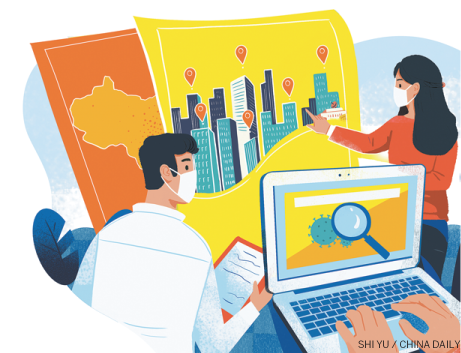
SHI YU/CHINA DAILY
Country working hard to minimize the gaps and inaccuracies in information about the novel coronavirus
With the passing of time and geographical spread, an epidemic entails increasingly large socioeconomic costs. Therefore, those responsible for policymaking and its implementation need to have firm resolve and agile responsiveness. In the case of the novel coronavirus, the role of the government, indeed policymaking in general, boils down to minimizing the gaps and inaccuracies in all kinds of information about the virus, with the goal of limiting the number of infections, reducing the negative socioeconomic impacts of its spread and preventing public panic.
The biggest information gaps are found in specialized information on the nature and origin of the novel coronavirus and effective treatments. From the Ministry of Science and Technology to the Hubei provincial government and the governments of other regions across China, research efforts are being stepped up to find a vaccine for the novel coronavirus epidemic. Some have teamed up with the World Health Organization and research institutions in countries such as the United States, India and Europe. However, it will take time to develop an effective vaccine.
The Chinese government has employed rigorous screening methods to gather information on infected patients, patients whose infection is in incubation period and those who have been in close contact with the former. Before a vaccine is developed, the focus of policy intervention is to isolate the source of the virus and to reduce interpersonal contacts. To contain the novel coronavirus epidemic, the authorities "sealed off" Wuhan, canceling transportation via train, plane and car into and out of the city. This was a necessary measure.
Additionally, strengthening awareness campaigns can help individuals take better precautions. Thanks to the prevalence of multimedia, the vast majority of the population know how to best protect themselves from the virus and they are actively avoiding occasions on which they might come into contact with carriers. They are also likely to report those at risk of carrying the virus. In turn, people returning from infected areas or those who are at risk of carrying the virus are more likely to agree to take quarantine measures.
How can we make the most of these measures and behaviors? In other words, how should we look at intervention measures taken across China up until now?
The most important intervention thus far has been beefing up medical resources, namely doctors, nurses, health screening staff and facilities. Unless diagnosed quickly, people who are incubating the virus or are susceptible to infection remain the biggest risk to the healthy population and pose the greatest challenge to controlling the spread of the epidemic.
Information gaps not only exist among the general public about each other's health status. Even medical staff, the government and the public at large do not have the full picture of the epidemic or the health status of given individuals.
Big data has proven to be an effective tool for intervention, through the timely release of the geographic information of the residential communities where new cases are confirmed and areas in which they frequent. For example, cities such as Shenzhen and Guangzhou in Guangdong province have the capacity to release highly specific geographic and spatial information of the spread of the epidemic in a timely manner, which will go a long way toward reducing the public's information gaps about the epidemic and helping populations in at-risk areas to increase awareness of prevention. With clarity of information, the government can significantly reduce the number and types of people subject to quarantine, relax quarantine measures in relatively safe areas, and thus use a separating equilibrium strategy more effectively.
China's experience of disclosure of information in the fight against the novel coronavirus can also serve as a valuable lesson for the international community.
First of all, China has strengthened cooperation with the international community, especially the World Health Organization when it comes to epidemiology and vaccine research and development. As epidemic response is the shared responsibility of all countries, the diagnosis and treatment of the novel coronavirus also calls for joint efforts by all parties. Shortly after the discovery of the first confirmed case of the coronavirus infection, Chinese scientists released the genetic sequence of the virus. The sharing of such information on a global level can help catalyze international cooperation on this new and mysterious pathogen.
Second, sharing all kinds of information on the epidemic that has been released in a timely manner with the international community can support global efforts in preventing and managing the spread of the epidemic. Information on the epidemic across different regions in China, as well as aggregate data on confirmed cases, suspected cases, deaths and cured cases are updated every day and released in a timely manner. The transparency and efficiency with which epidemic-related information has been disclosed are extremely valuable for other countries that want to know how China is doing in terms of epidemic control and prevention.
Last, but absolutely not the least, as a responsible stakeholder, China has undertaken strict health screenings for all entries into and exits out of the country, so as to control the cross-border spread of the virus. In all major cities across China, all residents and visitors who enter and exit the city (or the country through the city) go through temperature checks and health screening. This is an example of responsible behavior that can help to minimize the spread of the virus from carriers to other cities and countries and can contribute to the protection of health and safety in other countries.
(The author is professor in the School of Social Development and Public Policy at Fudan University. The author contributed this article to China Watch, a think tank powered by China Daily. )






